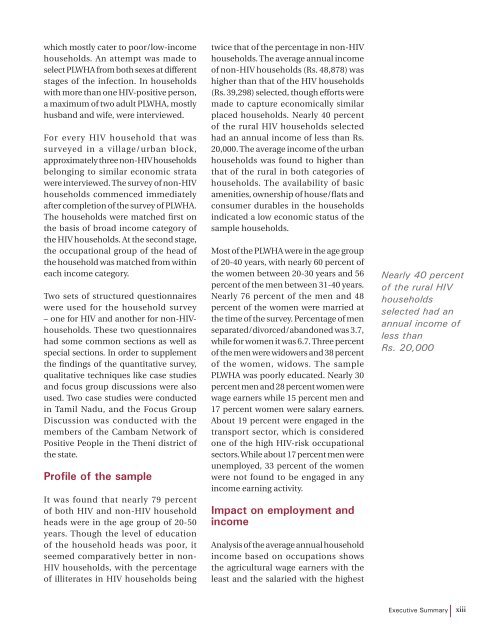Socio-Economic Impact of HIV and AIDS in Tamil nadu
Socio-Economic Impact of HIV and AIDS in Tamil nadu
Socio-Economic Impact of HIV and AIDS in Tamil nadu
You also want an ePaper? Increase the reach of your titles
YUMPU automatically turns print PDFs into web optimized ePapers that Google loves.
which mostly cater to poor/low-<strong>in</strong>come<br />
households. An attempt was made to<br />
select PLWHA from both sexes at different<br />
stages <strong>of</strong> the <strong>in</strong>fection. In households<br />
with more than one <strong>HIV</strong>-positive person,<br />
a maximum <strong>of</strong> two adult PLWHA, mostly<br />
husb<strong>and</strong> <strong>and</strong> wife, were <strong>in</strong>terviewed.<br />
For every <strong>HIV</strong> household that was<br />
surveyed <strong>in</strong> a village/urban block,<br />
approximately three non-<strong>HIV</strong> households<br />
belong<strong>in</strong>g to similar economic strata<br />
were <strong>in</strong>terviewed. The survey <strong>of</strong> non-<strong>HIV</strong><br />
households commenced immediately<br />
after completion <strong>of</strong> the survey <strong>of</strong> PLWHA.<br />
The households were matched first on<br />
the basis <strong>of</strong> broad <strong>in</strong>come category <strong>of</strong><br />
the <strong>HIV</strong> households. At the second stage,<br />
the occupational group <strong>of</strong> the head <strong>of</strong><br />
the household was matched from with<strong>in</strong><br />
each <strong>in</strong>come category.<br />
Two sets <strong>of</strong> structured questionnaires<br />
were used for the household survey<br />
– one for <strong>HIV</strong> <strong>and</strong> another for non-<strong>HIV</strong>households.<br />
These two questionnaires<br />
had some common sections as well as<br />
special sections. In order to supplement<br />
the f<strong>in</strong>d<strong>in</strong>gs <strong>of</strong> the quantitative survey,<br />
qualitative techniques like case studies<br />
<strong>and</strong> focus group discussions were also<br />
used. Two case studies were conducted<br />
<strong>in</strong> <strong>Tamil</strong> Nadu, <strong>and</strong> the Focus Group<br />
Discussion was conducted with the<br />
members <strong>of</strong> the Cambam Network <strong>of</strong><br />
Positive People <strong>in</strong> the Theni district <strong>of</strong><br />
the state.<br />
Pr<strong>of</strong>ile <strong>of</strong> the sample<br />
It was found that nearly 79 percent<br />
<strong>of</strong> both <strong>HIV</strong> <strong>and</strong> non-<strong>HIV</strong> household<br />
heads were <strong>in</strong> the age group <strong>of</strong> 20-50<br />
years. Though the level <strong>of</strong> education<br />
<strong>of</strong> the household heads was poor, it<br />
seemed comparatively better <strong>in</strong> non-<br />
<strong>HIV</strong> households, with the percentage<br />
<strong>of</strong> illiterates <strong>in</strong> <strong>HIV</strong> households be<strong>in</strong>g<br />
twice that <strong>of</strong> the percentage <strong>in</strong> non-<strong>HIV</strong><br />
households. The average annual <strong>in</strong>come<br />
<strong>of</strong> non-<strong>HIV</strong> households (Rs. 48,878) was<br />
higher than that <strong>of</strong> the <strong>HIV</strong> households<br />
(Rs. 39,298) selected, though efforts were<br />
made to capture economically similar<br />
placed households. Nearly 40 percent<br />
<strong>of</strong> the rural <strong>HIV</strong> households selected<br />
had an annual <strong>in</strong>come <strong>of</strong> less than Rs.<br />
20,000. The average <strong>in</strong>come <strong>of</strong> the urban<br />
households was found to higher than<br />
that <strong>of</strong> the rural <strong>in</strong> both categories <strong>of</strong><br />
households. The availability <strong>of</strong> basic<br />
amenities, ownership <strong>of</strong> house/flats <strong>and</strong><br />
consumer durables <strong>in</strong> the households<br />
<strong>in</strong>dicated a low economic status <strong>of</strong> the<br />
sample households.<br />
Most <strong>of</strong> the PLWHA were <strong>in</strong> the age group<br />
<strong>of</strong> 20-40 years, with nearly 60 percent <strong>of</strong><br />
the women between 20-30 years <strong>and</strong> 56<br />
percent <strong>of</strong> the men between 31-40 years.<br />
Nearly 76 percent <strong>of</strong> the men <strong>and</strong> 48<br />
percent <strong>of</strong> the women were married at<br />
the time <strong>of</strong> the survey. Percentage <strong>of</strong> men<br />
separated/divorced/ab<strong>and</strong>oned was 3.7,<br />
while for women it was 6.7. Three percent<br />
<strong>of</strong> the men were widowers <strong>and</strong> 38 percent<br />
<strong>of</strong> the women, widows. The sample<br />
PLWHA was poorly educated. Nearly 30<br />
percent men <strong>and</strong> 28 percent women were<br />
wage earners while 15 percent men <strong>and</strong><br />
17 percent women were salary earners.<br />
About 19 percent were engaged <strong>in</strong> the<br />
transport sector, which is considered<br />
one <strong>of</strong> the high <strong>HIV</strong>-risk occupational<br />
sectors. While about 17 percent men were<br />
unemployed, 33 percent <strong>of</strong> the women<br />
were not found to be engaged <strong>in</strong> any<br />
<strong>in</strong>come earn<strong>in</strong>g activity.<br />
<strong>Impact</strong> on employment <strong>and</strong><br />
<strong>in</strong>come<br />
Analysis <strong>of</strong> the average annual household<br />
<strong>in</strong>come based on occupations shows<br />
the agricultural wage earners with the<br />
least <strong>and</strong> the salaried with the highest<br />
Nearly 40 percent<br />
<strong>of</strong> the rural <strong>HIV</strong><br />
households<br />
selected had an<br />
annual <strong>in</strong>come <strong>of</strong><br />
less than<br />
Rs. 20,000<br />
Executive Summary<br />
xiii
















